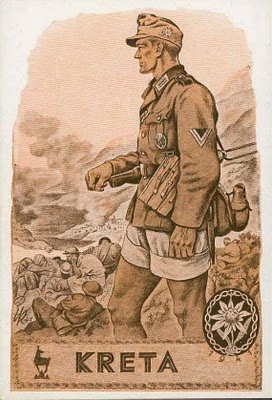Gebirgsjäger

A member Gebirgsjäger of 1. Gebirgsdivision. Note the buttons on his hat with a picture of Edelweiss!
+with+Edelweiss+insignia.jpg)
Mountains hat (Bergmütze) M43 German gray with Edelweiss emblem on the side and made of wool. Usually cap look "simple" is used by foot soldiers and not officers

Gebirgsjäger Patrol is resting in the snowy mountains during the fighting in the Caucasus (December 22, 1942).
Gebirgsjäger , which literally means the Hunter Mountain , is the German designation for mountain infantry . Said Hunter ( Jäger ) is itself a traditional German name for calling rifle troops ( sometimes confused with the vanguard or light infantry , known as Fusilier in Germany ) . Austrian mountain infantry has its roots in three regiments " Landesschützen " age of the Austro- Hungarian Empire while the German Mountain Infantry is the successor to the tradition Alpenkorps ( Alpine Corps ) days of World War I. Both German and Austrian mountain infantry , both share the same flower emblem Edelweiss ( German : Edelweiß ) . The first emblem first introduced by Emperor Franz Joseph of Austria- Hungary in 1907 and pinned as a symbol Landesschützen regiments . These troops wore their Edelweiss on the collar of his uniform . When the Germans came Alpenkorps assist in maintaining Landesschützen southern border region of the Austro- Hungarian Italian attack in May , 1915, Landesschützen expressed his gratitude to the members Alpenkorps awarded their badge of honor : Edelweiss .
During World War II Wehrmacht and Waffen - SS units formed their own Mountain Infantry .
Full corps was formed in Norway in 1941 . Division - division usually armed with only mild , with most means of transportation using donkey ! Although Gebirgsjäger equipped with an automatic weapon that is considerably less than the regular infantry , but the crew MG34 or MG42 machine guns they usually just got a lot more ammunition . We usually recognize this mountain troops with ease , simply by looking at the Edelweiss sleeve insignia or cap them .
Gebirgsjäger participated in many battles in World War II , including Weserübung Operations , Operations Silber Fuchs , Fuchs and Operations Operations Platin Arktis Fuchs , operations in the Caucasus , the Gothic Line , the invasion of the island of Crete and the battles in the Vosges region in France .
The famous Wehrmacht sniper like Matthäus Hetzenauer and Josef " Sepp " Allerberger derived from Gebirgsjäger units operating on the Eastern Front .
